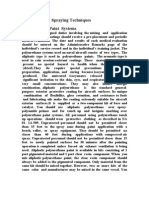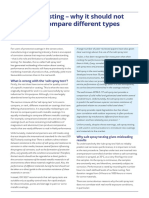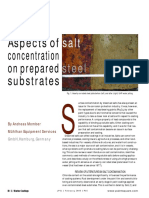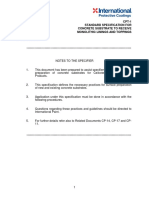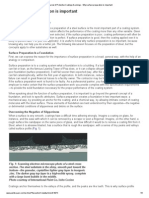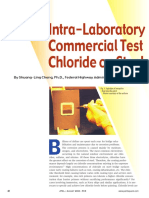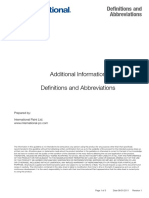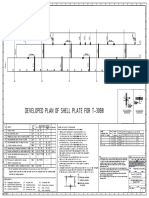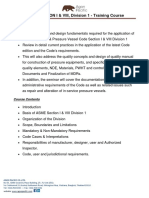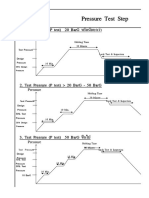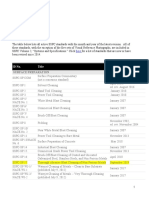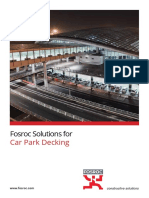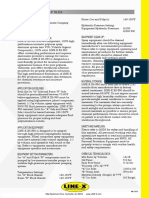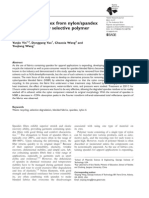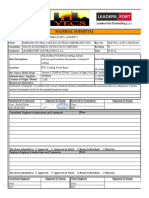Tech Coating Selection
Tech Coating Selection
Uploaded by
Karthikeyan ShanmugavelCopyright:
Available Formats
Tech Coating Selection
Tech Coating Selection
Uploaded by
Karthikeyan ShanmugavelCopyright
Available Formats
Share this document
Did you find this document useful?
Is this content inappropriate?
Copyright:
Available Formats
Tech Coating Selection
Tech Coating Selection
Uploaded by
Karthikeyan ShanmugavelCopyright:
Available Formats
November 12-16, 2000 Nashville, Tennessee
THE SELECTION, APPLICATION AND INSPECTIO N OF 100% SOLIDS POLYURETHANE COATINGS FOR CORROSION PROTECTION Shiwei William Guan, Ph.D. Vice President, Research & Development Madison Chemical Industries Inc., 490 McGeachie Drive, Milton, Ontario L9T 3Y5 Canada Phone: (905) 878-8863; Fax: (905) 878-1449 E-mail: sguan@madisonchemical.com Website: www.madisonchemical.com
Abstract: This paper discusses the proper selection, application and inspection of polyurethane coatings for corrosion protection of various substrates.
the polyurethane coatings such as defects caused by offratio spraying. This paper discusses the proper selection, application and inspection of polyurethane coatings for corrosion protection of various substrates.
INTRODUCTION 100% solids plural component polyurethane coatings provide corrosion protection for many different structures today, such as storage tanks, oil and gas piping, water and wastewater pipelines, bridges, ships, and other marine facilities. The products have been effective because of their outstanding life expectancy and performance, resistance to aggressively corrosive environments, high abrasion resistance, low temperature curing capability, strong adhesion, high film build, fast application, and compliance with the most rigorous regulations on volatile organic compound (VOC) emissions. However, the selection, application, and inspection of a polyurethane coating can be a difficult task based on various attributes, including coating chemistry, coating properties, surface preparation requirements, application parameters, resistance to environmental attack, economics, and worker safety. Results of various performance laboratory tests on the lining systems can play a major role in the selection exercise. Laboratory testing of different lining systems and their various performance attributes form the basis in establishing correlation with field performance and long term life expectancy. Proper application and quality assurance of the 100% solids polyurethane coatings are important because special plural component application equipment is normally required, and application requirements are more rigorous than conventional low solids coatings or other types of coatings. New parameters are also involved in the inspection and trouble shooting of
HOW CHEMISTRY AFFECT S SELECTION, APPLICATION, AND INSPECTION 100% solids polyurethane coatings usually consist of two components: one isocyanate-rich solution and one polyol-rich solution. This has been defined as an ASTM D16 Type V polyurethane coating. Such a polyurethane coating film is formed when the two components are combined; a rapid and exothermic chemical polymerization reaction takes place. By definition, the term "100% solids" means the coating system does not use any solvent to dissolve, carry or reduce any of the coating resins. Further, the resins normally still in a liquid state, will convert, 100%, to a solid film after application. The viscosity of the coating system is determined by the selection and design of the resin components. It is not determined by the addition of a solvent, although solvents have usually been used in the industry for the purpose of reducing viscosity. The first important consideration in selecting a suitable polyurethane coating for corrosion protection is to decide if aliphatic polyurethanes or aromatic polyurethanes should be used. Aliphatic polyurethanes are polyurethanes based on aliphatic isocyanates (e.g. HDI and IPDI) and mostly polyester and/or acrylic polyols. Aromatic polyurethanes are polyurethanes based on aromatic isocyanates (e.g. MDI and TDI) and mostly polyether polyols. Aliphatic polyurethanes are more expensive, but provide the best UV resistance and color stability among all types of industrial coatings. They are
therefore often used for exterior applications and any other places where color stability is concerned. The design of a 100% solids aliphatic polyurethane system is very difficult and few coatings manufacturers have such a technology. Aromatic polyurethanes are cheaper and often used for interior, lining or underground applications. Depending upon their formulation design, aromatic polyurethanes will exhibit a certain degree of color change ("yellowing") after a few days/months UV exposure. However, their UV resistance is generally better than that of common epoxies. Most 100% solids polyurethanes available today are aromatic polyurethanes. The second important consideration is whether elastomeric polyurethanes or rigid polyurethanes should be used. The properties of 100% solids polyurethanes vary from very soft, rubbery elastomers (like running shoe soles) to hard, ceramic like systems - a good chemist can formulate the 100% solids polyurethanes to do almost anything. The chemical bonds in the more rigid systems are highly cross-linked to each other to create hard, dense systems that have very good chemical and mo isture resistance. The rigid systems usually have excellent adhesion and are the best choice for the corrosion protection of metals. On the other hand, the elastomers have a more linear structure with much less cross linking that allows them to be very stretchy and elastic. These systems normally have great impact strength and flexibility, but relatively poor adhesion and chemical resistance. Elastomers are better suited to protecting substrates that tend to move and flex like concrete but do work as well on metallic substrates. The chemical and corrosion resistance of the elastomers can be improved if the systems are applied relatively thick. The format of a polyurethane coating system plays an important role in the selection, application and inspection. The best 100% solids plural component polyurethane coatings are the ones that are in a 1:1 mixing ratio. This is because: a) Isocyanates and polyols in a 100% solids polyurethane system are reacted normally by around the ratio range of 1:1;
chance to cause mismetering problems (often called as off-ratio) during its application. The higher ratio is, the higher possibility it will occur. There is a tendency to misunderstand polyurea or polyurethane coatings. In many cases, people tend to mix up polyurea coatings and polyurethane coatings. Thus, polyurethane coatings have become a generic term for coating systems based on polyisocyanate reaction. Polyurea coatings normally use amines as coreactants to react with isocyanates. This reaction is extremely fast (within a few seconds or minutes). As a result, polyurea coatings tend to have a very limited pot life and their recoat time becomes a problem in cases when multiple coats occur. A polyurea linkage, however, will have better heat and high temperature resistance than a polyurethane system with polyols as coreactants. The rapid and exothermic chemical reaction between the isocyanate component and polyol component also plays a role in the selection, application, and inspection of 100% solids polyurethane coatings. Most 100 percent solids plural component polyurethane coatings cure rapidly. Typical pot life ranges from a few seconds to several minutes. Their rapid cure makes them ideal for shop coating work. On one hand, the quick setting results in high or even unlimited film build per coat, high throughput, and early warning of potential problems or defects in the application inspection process. On the other hand, too fast setting may cause missing recoat windows, poor wetting of the substrate surface, and other potential coating problems. Another aspect of the coatings' chemistry that affects selection, application and inspection of polyurethanes is their sensitivity to moisture. If water is absorbed by the isocyanate component, it will react with the isocyanate, causing thickening and even gelation of the material. Water also r duces the reactivity of the e isocyanate by reacting with a part of it. Because water is normally soluble in polyols, there is no apparent reaction when water is absorbed by the polyol component. However, when the water-contaminated polyol component reacts with the isocyanate component, carbon dioxide (CO2 ) gas is evolved from the reaction, generating bubbles within the coating during cure. If there are a significant number of bubbles in the coating, chemical and physical properties of the coating will be diminished. The finished surface of the coating may become dull and have the appearance of orange peel; foaming, blistering, and bubbling may also occur; and gloss will be reduced. To avoid the moisture problem, one will select those polyurethane systems that are less moisture sensitive, and also pay attention to proper storage, application, and inspection.
b) To apply fast setting 100% solids polyurethane coatings with plural component equipment, the 1:1 format is the easiest way to configure the set up. However, it requires that the both components have the same or close viscosity. This is the most difficult challenge for a coatings chemist in designing a 100% solids polyurethane coating system; c) A 100% solids polyurethane coating system with a mixing ratio higher than 1:1 will have better
As with conventional coatings, proper surface preparation is essential to 100% solids polyurethanes. Adhesion values of plural component coatings to a well prepared surface will vary from formulation to formulation. Without a primer, adhesion values in the range of 1,500-3,000 psi (10-20 MPa) have been measured. However, because of the rapid cure, intercoat adhesion can be a serious problem if the applicator misses the recoat window.
polyols: 2,000-5,000) are generally higher than those for amine based epoxy coatings (amine: 500-4,000; epoxy resins: <2,000). A greater value of LD50 indicates that the material is less toxic. A coatings ability to be quickly and efficiently repaired in the factory or field is an important attribute of any system. A long cure time or an elaborate curing process can cause inefficiencies for shop and field applications. Standard performance tests have been developed and used over many years to evaluate various coating and lining systems for their use as corrosion protection coating and lining systems. In this study, tests were conducted according to the following testing standards: Adhesion (ASTM D4541) Abrasion Resistance (ASTM D4060) Cathodic Disbondment (ASTM G95) Chemical Resistance (ASTM D714) Flexibility (ASTM D522) Impact Resistance ( ASTM G14) Salt Spray Resistance (ASTM B117) Water Absorption (ASTM D570)
THE PROPER SELECTION OF 100% SOLIDS POLYURETHANE COATINGS Deciding on a corrosion protective coating system is a balance of: a). The environmental and safety impact of the coating application; b) The economic impact of the coating on the project; and c) Performance and life expectation of the coating. To do so, we shall consider the coatings a) handling and safety characteristics; b) application and repair attributes; c) physical performance; d) case histories, and e) cost analysis. The corrosion protection market has always required a corrosion protection system that is environmentally friendly, work safe, durable and able to withstand the corrosive environment. For a coating/lining system to be classified as a suitable corrosion protection system, the coating/lining must expose little or no metal/substrate surface to the environment while also being resistant to environmental, mechanical and chemical damage throughout its service life. Handling and safety characteristics include VOC, percentage of solids, as well as whether the coating contains any hazardous ingredients such as amines, solvents, and isocyanate monomers. In the past, there has been a misinformed impression in the coating industry that compared to an epoxy system, polyurethane coating and lining systems were not as safe to use as epoxies due to the toxicology of the resins (polyols and especially isocyanates). The main hazardous pre-cursor of a polyurethane is an isocyanate monomer. While there are many different types of isocyanates available in the market, most isocyanates used today in 100% solids polyurethane coatings are of the MDI (Diphenylmethane Di-isocyanate) type. In these lining systems, particularly in rigid polyurethane systems, polymeric MDI and special formulating technology are also used to further reduce the level of isocyanate monomer in the finished system. As a result, the polyurethane systems are in fact safer to use compared to most epoxy systems. For example, the single oral LD50 (mg/Kg) value (lethal dose for 50% of the laboratory rats) among resins for MDI based polyurethanes coatings (polymeric MDI: 5,000-10,000;
The adhesion of a protective coating system to the substrate is considered to be a good indicator of the coatings ability to resist corrosion and therefore represents longevity of the coating. Generally, the better the adhesion, the longer the coating will last. Most elastomeric polyurethane coatings have lesser adhesion values than rigid polyurethanes when a primer is not used. Cathodic disbondment is one measure of the undercutting resistance of a coating/lining system. Experience in the oil and gas pipeline industry has clearly shown that coatings/linings with better cathodic disbondment resistance have better corrosion resistance and greater longevity. The coating/lining systems with good adhesion to the steel substrate tend to have a similar resistance to cathodic disbondment. If a coating/lining is able to adhere to the steel substrate, it will therefore tend to resist the undercutting damage of corrosion, thereby offering a longer service life. The impact resistance test method represents the coatings ability to withstand damage due to a direct impact with another object. This test method is often required for pipeline coating performance results where impact and damage resistance is of greater importance. This test is also relevant for evaluation of internal lining systems due to its ability to predict good lining performance and resistance to damage.
For any pipeline internal lining application, the lining must be able to withstand the constant flow o f liquid and any particulates. Normal municipal pipeline velocities are in the range of 8 to 16 feet per second (2 to 4 meters per second) but these rates can increase in some cases to over 30 feet per second. The corrosion protection lining must be capable of withstanding the constant abrasion caused by the passing water at the various velocities. Premature failure of the lining system can occur, thereby exposing the steel substrate to the corrosion cycle. In the Taber Abrasion Test (ASTM D4060), a sample was rotated under a specific weight (1 kilogram) against a grinding wheel (CS17) for a defined number of revolutions (1,000 cycles). The samples were evaluated by measuring the weight of the sample before and after the test. The resulting weight loss indicated the comparative ability of the lining to resist abrasion and wear. The lower the reported weight loss, the more abrasion resistant the lining. Flexibility is a good indicator of a coating/linings ability to withstand the cracking, disbonding, or other mechanical damage of the coating/lining that can occur from handling and bending the steel pipe not only in the field but also in the factory. Total applied cost of a coating project equals coating materials cost plus application cost. For instance, the materials cost of 100% solids polyurethanes may be slightly higher than that of epoxy coatings, and higher than that of cement-mortar. However, the application cost of 100% solids polyurethanes is relatively lower because of its one coat application and fast curing. The true cost of a coating is not just the applied cost ($/m2 ). It is the ($/m2/year of life). Based on lab testing and field experience, 100% solids rigid polyurethanes will outlast conventional coating technologies (e.g. epoxy and cement) in similar conditions at similar thickness by 20 to 30% 4-5 . In addition to the application cost, maintenance cost of a coating system is also of consideration. 100% solids polyurethane will result in much less damage than other coatings such as tape and cement mortar4-5 .
management can be improved with the following guidelines. Scheduling. Improve scheduling to reduce time pressure, to choose an experienced applicator, to avoid applying coatings under bad weather conditions, to ensure that the oldest materials are always used first, and to reduce material waste. Specifying. Do not specify 100 polyurethanes that have not been remove off moisture. Also, avoid systems with very different viscosity each component. % solids treated to specifying values for
Verifying. Check the product label to ensure proper material has been delivered. Check the temperature of the coating material to ensure the material has not been frozen. Check all containers and ensure they are tightly sealed and have not been tampered with so that atmospheric moisture will not contaminate the material. Ensure that the material is stored off the ground on skids in a well ventilated area and protected from heat sources. Training. Adequately train application personnel on surface preparation, handling and storage of materials, application techniques, inspection, and reporting. Maintaining. Management should allocate funds to properly maintain application equipment and tools. Monitoring. Continuously monitor application conditions and equipment parameters. Document them daily in the Quality Assurance Report, discussed below. Troubleshoot problems immediately.
THE PROPER APPLICATION AND INSPECTION OF 100% SOLIDS POLYURET HANE COATINGS Management support plays an important role in the successful application of 100 percent solids polyurethanes. Coating defects and failures are expensive, and avoiding them requires work, by all levels of personnel, not just the applicator. Quality assurance
Most often, coating defects and failures occur because of improper surface preparation or coating application. Some quality assurance tests for avoiding surface preparation problems in the use of polyurethanes are listed below. They are similar to the surface preparation tests for other industrial ma intenance coating systems. Moisture. Moisture (dew or frost) on a substrate will cause poor adhesion and other defects in 100 percent solids polyurethanes. Therefore, apply the coating only if the substrate temperature is 5 o F (3o C) above the dew point. B efore abrasive blasting, determine the dew point by using a
sling psychrometer and a psychrometric chart. Be sure to use the temperature of the substrate (e.g., steel or concrete), rather than the atmospheric temperature when applying the dew point criterion. Contamination. If steel grit is used, obtain a sample of it and place the sample into a bottle with clean water. Shake well. If oil appears on the surface of the water, the grit is contaminated, and new grit should be used. If dry blasting is used, be sure the air lines are free of moisture and oil before use. This can be done by air blasting into a clean, dry white rag to determine if the airlines are contaminated. If the rag stays white and dry, the air is clean. If the rag is dirty, oil is in the airstreams, and the oil separator should be checked. If the rag is wet, moisture is escaping, and the moisture separator should be checked. Surface cleanliness. Abrasive blasting will not remove oil or grease. Blasting will simply drive contamination deeper into the profile being created. Before it is blasted, the surface must be cleaned with solvents or detergent solutions. To detect the presence of dust and other surface debris, apply a strip of scotch tape to the surface, remove it, and visually inspect the underside of the tape for dust or other contaminants. If it is dirty, repeat the cleaning and testing procedure until the tape comes off without debris. Blast profile. Use replica tape to determine the profile depth on steel. For immersion service of 100 percent solids polyurethanes, a Near White Blast (SSPC-SP 10, NACE #2) should be specified with an angular profile of at least 2.5 mils (65 micrometers). For atmospheric service a commercial blast (SSPC-SP 6, NACE #3) with a profile of at least 1.5 m (38 micrometers) is ils desirable.
pumps can also help applicators manage the materials usage. The counter will record the number of strokes by the pump motion used during the application. As a point of reference, 0.046 gal. or about 6 fluid ounces (0.17 L) of the coating material is consumed per stroke if certain proprietary 3,000 psi (2.1 MPa) displacement pumps are used. Holiday detector test. Holiday detection should be carried out after or between coating applications. The holiday test will find nicks, pinholes, and other film discontinuities. A low voltage holiday detector is often used. It consists of the detector, a ground cable, and a sponge electrode. High voltage holiday detectors are also being used for DFT above 20 mils (500 micrometers) on applications such as pipe lining and exterior coating projects. For steel pipe, we recommend a detecting voltage of 100 volts per mil. Adhesion tests. Adhesion tests should also be conducted after each coat. The adhesion test can be a modified version of ASTM D 3359, the cross hatch adhesion test. An X-cut is made in the coating film to the substrate to pull off the coating and measure adhesion. Instead of using pressure sensitive tapes, use a knife to pry off one of the corners that was created by scribing the X. Acceptance criterion will vary from specification to specification. A pull-off adhesion test (e.g., ASTM D 4541) is also very common. For exterior application, a minimum adhesion of 750 psi (4 MPa) is required; for immersion use, such as tank lining, adhesion of more than 1000 psi (7 MPa) is usually desirable. The minimum adhesion value required by the newly published AWWA/ANSI C222 Standards for Polyurethane Coating for external and internal applications of steel water pipeline is 1500 psi (10.5 MPa). Common application problems and resolutions associated with the application of 100% solids polyurethane coatings are discuss as below: Uneven coloring and uncured resins. Uneven coloring is mainly due to phase separation and pigment settling when the materials have not been recirculated or agitated before spray. It can also be attributed to clogged in-line filters or build-up on mixers and spray guns, particularly for the polyol component side that contains pigments and extenders. In addition, total or partial restrictions in the isocyanate component side may cause uneven coloring and uncured areas. Blistering. This is one of the most commo n failures in the application of plural component polyurethanes. The size of the blister usually
Quality assurance tests during application will ensure the successful application of 100% solids polyurethane coatings. These tests include temperature check, discharge pressure check, and volume check, which are described in reference 1. Film thickness must be checked. The coatings may be formulated to be applied to thicknesses above 100 mils (2.5 mm) per a multi-pass, single coat. This is totally different from spraying conventional, solvent-borne coating systems. Regularly checking the wet coating thickness with a wet film gauge can prevent wasting the materials. Placing a numerical counter in the displacement
depends on the degree of adhesion of the coating to the surface and the pressure of the gas or liquid within the blister. The usual causes of blistering are a contaminated substrate surface (e.g., moisture, oil, grease, sweat, dust) or an improper mismetering (off-ratio mixing) of the 2 components. Blistering can also be caused by gun 'spits'. It can be avoided by making sure the surface is clean; by only triggering the spray gun off target before applying the coating to the substrate; by keeping the product supply warm; and by regularly cleaning filters, mixers, and spray guns to avoid cavitations and off-ratio spray. Overspray. Overspray is also common with 100 percent solids polyurethanes. It is caused by poor gun adjustment or coating at too great a distance from the substrate. Failure occurs when pinpoint rusting forms at an oversprayed area. Planning spray patterns along with proper gun control will eliminate this problem. Under normal conditions, the gun should be held perpendicular to the substrate with the tip 18 to 24 in. (0.5 to 0.6 m) away. Holidays. Holidays often occur when the applicator has missed coating the surface, or where thin spots exist i difficult-to-coat areas n such as inside corners, along welds, around bolts and rivets, or wherever there are angles in the substrate surface. Attention to detail and spraying with a 50 percent overlap will help avoid holidays. Delamination. Delamination occurs when the coating fails to adhere to the surface. A closely related phenomenon is intercoat delamination, the loss of adhesion between coats. It occurs most often where surface preparation is poor, the substrate is contaminated, or repair or maintenance coatings are being applied over existing coatings. If the same type of coating is being applied over the existing coating, the failure is usually caused by missing the recoat window, or by the poor surface condition of the existing coating. (The original coating may be chalky or have embedded dirt.) Delamination may also be caused by an off-ratio spray. Around the off-ratio area, intercoat adhesion will be very poor. Fisheyes. Fisheyes or cratering can be an application problem, a material problem, or both. When they are a material problem, fisheyes occur when the material has a very high or very
low surface tension; silicone or oil contamination is a possible cause. For the most part, however, fisheyes are an application problem caused by contaminants such as dirt on the surface or the wet coating. Often, oil in atomizing air contaminates the surface. Regular maintenance of the compressor and the use of airline dryers will ensure clean, dry air. Pinholing. Pinholes can result from overspray, surface contamination, or solvent entrapment. Pinholes may also be a result of moisture contamination of the B (polyol) component or of other types of contamination (e.g., silicone) in the coating. As with overspray, pinholing can be caused by improper gun adjustment. If the gun does not atomize properly, air becomes trapped in the coating. Pinholing can also be caused by applying the coating too close to the surface, creating an area in the center of the fan where too much material is applied and where air bubbles are trapped in the wet coating. Cracking. Cracking could be an issue if aromatic rather than aliphatic polyurethane coatings are used for long term aboveground exposure. In order for cracking to occur, several factors must be occurring at the same time: a). Temperature Extremes - temperature variations cycling over a prolonged period (either from cool to very hot or freeze/thaw or both; b). Lack of Adhesion. Adhesion does not change significantly over time and a well-adhered coating is quite resistant to undercutting; c). A Stress-Inducing Mechanism -- A coating can be subject to external stresses or an internal stress (the thicker a coating is, the greater the internal stresses). Where the initial bond is marginal, this can set up horizontal stresses at the interface between the substrate and the coating or it can make the coating vulnerable to perpendicular stresses near the external stress source. The latter is observed as a crack in the coating. There are ancillary factors to be considered as well. Darker colors will be affected by temperature extremes to a greater extent than lighter ones. Coating application factors such as intimacy of mix and off-ratio would need to be considered (these do not appear to be factors based on the samples recently sent to us). The key solution on the cracking issue is to ensure the best adhesion of the polyurethane coating to the substrate.
Proper maintenance can prevent many of the above application problems with plural component polyurethanes. Coatings manufacturers can be asked for
detailed recommendations of proper setup, shutdown, and maintenance procedures. Typical examples are given here. Purging the pump. Flush the pump with di-octyl phthalate. Strong solvents such as xylene and methyl ethyl ketone are not recommended to flush the application equipment because coatings that have solidified on the inner walls of the equipment will absorb these solvents and become loose. Inevitably, these loosened solids will clog filters and mixing orifices downstream. Cleaning filters. In-line filters and high-pressure filters should be cleaned daily. Apply a film of lithium grease to the threads of the filter housing to make future cleaning easier. Protecting the upper packing. Lubricate the displacements rods with throat seal to prevent isocyanate crystals from forming by reacting with atmospheric moisture. Isocyanate crystals will act much like sand paper and destroy the upper packings as the displacement piston extends and retracts. In addition, periodically tighten the packing nut so it is snug. Saving leftover materials. Wasting leftover materials by specifying the use of only filled drums is discouraged. Drums that have not been completely emptied should be filled with clean, dry nitrogen gas and tightly sealed to prevent the remaining materials from reacting with moisture.
of the coating should be also contacted for proper application recommendations, and even better the application should be limited to a qualified applicator trained and approved by the coatings manufacturer. During the project, do not assume that the foreman knows exactly what is required. Provide him with the specifications and written directions. A sound field quality control inspection program that includes quality assurance form management completes the circle. Quality begins with engineering. A good specification goes a long way toward getting a good coating job. For instance, specifying an elastomeric polyurethane coating direct-to-steel without a primer is normally not a good idea because of its relatively poor adhesion and cathodic disbondment resistance. When the specification schedule or work plan is flawed, the contractor needs to address any anticipated problems before the bid. What the engineer desires may not be the most cost effective, or differing field conditions may necessitate some changes be made. Such changes in scope or application are best made prior to the bid. The material approval process is often viewed as a formality, and often is. Especially when the approval being sought is for a product already specified by the engineer. However, "equal" products or "similar products by listed vendors subject to engineer's approval" call for additional consideration. The contractor is often suggested to alternate products based on price and availability without consideration for actual performance. The assumption is that the vendor does indeed manufacture a suitable crossover product with the exact same performance characteristics as the product called out or named in the specification. This is not always the case. Sometimes the manufacturer's sales representative may submit a similar, but not necessarily equal product that is favorable in price, without meeting the performance criteria. The sales person may not even have a clue as to product suitability. A similar product by another vendor may or may not have the same performance characteristics as the products actually named o listed in the specification. r Approval of an alternate product should require the same level of testing and research that went into the approval of the listed products. The problem is that this too is not always the case. There have even been cases where the material approval is based on the product manufacturers salesman's recommendation alone, without verification and without the salesman knowing the actual service or the exact conditions his or her product will be exposed to in the field. A painting foreman or coating inspector charged with the daily inspection and documentation of the work must have the proper tools to do his job properly. The
A quality assurance report is recommended to be completed each day. Record the date of the spray, and briefly describe the project. Note the batch numbers of both the A and B containers. Record the A and B operating pressures and the temperatures of the 2 components at the heater and supply drum. Note major variations during spray. A record of the ambient measurements should be taken where the coating will be applied. Record the blast media and the color and profile of the blast. Record coating consumption and area coated to keep track of the material usage. There is also a Quality Culture issue involved in the proper application and inspection of 100% solids polyurethane coatings. Quality Culture or Total Quality Management means that quality is addressed at every step of a project. That means the estimator considers quality in the bid, the engineer considers quality in the material submittal review and everyone in between is on the same team when the project starts. Communicating all of the project requirements to the applicator and orientating the workers are keys to success in the field. The manufacturer
minimum instrument and reference data on hand during basic coating inspection should include: Applicable specifications, material technical data, application procedures, product material safety data sheets (MSDS) and referenced painting industry association standards such as SSPC, NACE, AWWA, ASTM, API, etc. that apply to the work. Proper health and safety gear such as the basic head, eye, foot and hearing protection. You should also have suitable clothing, a respirator with the proper filters and fall protection. The inspector must also meet the necessary health physics requirements such as pulmonary function test (PFT) or spirometry and pass a basic physician's physical. Other site specific requirements such as special plant safety orientation training or blood lead testing may be required. Psychrometer, surface temperature thermometer and psychometric charts to record and calculate environmental conditions. Wet film and dry film gages to verify the applied and cured coating thicknesses. Surface preparation standards, both written and visual. Surface profile comparator or profile replica tape. Adhesion testers and proper glue materials for the adhesion testing. The later is one of the common problems with the adhesion testing on 100% solids rigid polyurethane coatings because their superior adhesion value (as high as 6000 psi (42 MPa)). Holiday testers. For coating thickness of less than 20 mils (500 microns), the recommended holiday tester will be a wet sponge low voltage tester. Higher voltages (100 volts per mil or 4 volts per micron are recommended) for coating thickness of higher than 20 mils (500 microns), and therefore a high voltage tester is needed.
Decision for a suitable polyurethane coating system is a balance of: a) the environmental and safety impact of the coating application; b) the economic impact of the coating on the project; and c) performance and life expectation of the coating. Coating selection is based on verified research, testing and/or experience. The proper materials must be procured, properly stored, handled and mixed correctly. Applicators must have the necessary knowledge, training and experience to apply the materials as intended under various, often less than ideal and sometimes adverse conditions. It is important to develop the kind of working environment, or quality culture that breeds success into the people doing the work, to ensure that tomorrow's coating job will be done correctly.
BIBLIOGRAPHY 1. Guan, Sh iwei., Assuring Quality When Applying 100 Percent Solids Polyurethanes, JPCL, December 1995, 74 2. ANSI/AWWA C222 Standard for Polyurethane Coatings for the Interior and Exterior of Steel Water Pipe and Fittings, March 1, 2000 3. Roebuck, A.H., and R.W. Foster. "100 Percent Solids Plural Component Urethane Coatings." JPCL, February 1988: 22-27 4. Kennedy H., "100 Percent Solids Polyurethanes, The Next Generation of Water Tank Linings." In Proceedings of the SSPC 1991 National Conference, Long Beach, CA, November 10-15, 1991 (SSPC 91-17), pp. 15-21. 5. Walker D. and Guan, S., Protective Linings for Steel Pipe in Potable Water Service. NACE Northern Area International Conference Corrosion Prevention 97, Toronto, Ontario, November 10-11, 1997 6. Soebbing, J.B., "Tips on Improving Application of Plural Component Polyurethane Linings to Pipelines." JPCL, May 1994: 148-155.
SUMMARY The impact of polyurethane chemistry on the proper selection, application, and inspection of 100% solids polyurethane coatings has been considered.
You might also like
- Safe Distance Stored Energy Calculator - Pneumatic TestingDocument3 pagesSafe Distance Stored Energy Calculator - Pneumatic TestingKarthikeyan ShanmugavelNo ratings yet
- The Industrial Coatings MarketDocument5 pagesThe Industrial Coatings MarketjagrititanuNo ratings yet
- Zoldine Ms-Plus: Key Performance AdvantagesDocument6 pagesZoldine Ms-Plus: Key Performance AdvantagesPratik MehtaNo ratings yet
- Methodology For PODIUM Landscape WP Polyurea WH 200 PDFDocument10 pagesMethodology For PODIUM Landscape WP Polyurea WH 200 PDF폴로 쥰 차No ratings yet
- Arkaz Product BroucherDocument5 pagesArkaz Product Brouchersk mukhtarNo ratings yet
- Painting FailureDocument21 pagesPainting FailureNnamdi Celestine NnamdiNo ratings yet
- KMS183 PDFDocument6 pagesKMS183 PDFSabyasachi Naik (Zico)100% (1)
- Performance Coatings - Greenheck FansDocument12 pagesPerformance Coatings - Greenheck Fansprsum_572100% (1)
- PolyurethaneDocument2 pagesPolyurethaneKokchuan WangNo ratings yet
- T 18Document10 pagesT 18khuramluck100% (2)
- Salt Spray Testing - Why It Should Not Be Used To Compare Different Types of CoatingsDocument2 pagesSalt Spray Testing - Why It Should Not Be Used To Compare Different Types of Coatingsdwimukh360100% (1)
- Coating IndiaDocument53 pagesCoating Indiaagustinusset100% (1)
- Aspects of Salt Concentration On Prepared Steel SubstratesDocument6 pagesAspects of Salt Concentration On Prepared Steel Substratesmuthukumar100% (1)
- 001CorrosionArticleAntiCorrosionTechWEIQ PDFDocument3 pages001CorrosionArticleAntiCorrosionTechWEIQ PDFJACK100% (1)
- Producing Coating Specifications That WoDocument11 pagesProducing Coating Specifications That WoAhmed hafez100% (1)
- Flooring Options For High Traffic Areas: Presented By: Jayson L. Helsel, P.E. KTA-Tator, IncDocument50 pagesFlooring Options For High Traffic Areas: Presented By: Jayson L. Helsel, P.E. KTA-Tator, IncJayesh100% (1)
- TSS - Overcoating Document - TSS-X CUT+TI-069-01+Overcoating+an+unknown+coatingDocument5 pagesTSS - Overcoating Document - TSS-X CUT+TI-069-01+Overcoating+an+unknown+coatingRifki Fathurrahman100% (1)
- Saes H 201Document9 pagesSaes H 201heartbreakkid132No ratings yet
- CPT 1 ConcreteDocument9 pagesCPT 1 ConcreteJossef.ahsan Jossef.ahsan100% (1)
- Hampel Iso-12944-PresentationDocument17 pagesHampel Iso-12944-PresentationAlbert Tok100% (1)
- Corrosion Performance of Epoxy Coated Reinforcing Steel - North America ExperienceDocument17 pagesCorrosion Performance of Epoxy Coated Reinforcing Steel - North America ExperiencebrahmabulNo ratings yet
- What Is The Cause of Chalking in Epoxy CoatingDocument11 pagesWhat Is The Cause of Chalking in Epoxy CoatingKalaiRazBalan100% (1)
- The Effect of Leach LayersDocument5 pagesThe Effect of Leach LayersChioibasNicolae100% (1)
- Performance Myth of IOZ and ZRDocument15 pagesPerformance Myth of IOZ and ZRkalesh100% (1)
- Astm D2621 2005Document26 pagesAstm D2621 2005Marc Padu100% (1)
- 2022-09-20 International Paint Approved Letter MHH SignedDocument6 pages2022-09-20 International Paint Approved Letter MHH SignedHaf100% (1)
- International Journal of Chemtech Research: Neetu SinghDocument5 pagesInternational Journal of Chemtech Research: Neetu Singhthai avvai100% (1)
- History Thermal SprayingDocument5 pagesHistory Thermal Sprayingmaverick_cvc100% (1)
- Guia de Proveedores de PinturasDocument28 pagesGuia de Proveedores de PinturasEDGrog100% (1)
- Data Sheet FBEDocument4 pagesData Sheet FBEAnonymous Xaf2033No ratings yet
- Barrier-Adhesion Principle For Corrosion PrtotectionDocument10 pagesBarrier-Adhesion Principle For Corrosion PrtotectionINRO Ingeníeria100% (1)
- Shin CombinedDocument29 pagesShin CombinedAce Ace100% (1)
- Boat Laning CoatingDocument1 pageBoat Laning Coatingwaleedyehia100% (1)
- Aqueous Coatings Guide: Chuck Malspeis Coatings Product Development ManagerDocument16 pagesAqueous Coatings Guide: Chuck Malspeis Coatings Product Development ManagerMohamed NouzerNo ratings yet
- Non Skid AreasDocument2 pagesNon Skid AreasHossain AnwarNo ratings yet
- BrederoShaw TP TropicEnvironment PDFDocument8 pagesBrederoShaw TP TropicEnvironment PDFMakrame BattazNo ratings yet
- PPL Su 2005 PDFDocument11 pagesPPL Su 2005 PDFresp-ect100% (1)
- Comparative Study On The Degradation of A Zinc-Rich Epoxy Primeracrylic Polyurethane Coating in Different Simulated Atmospheric SolutionsDocument17 pagesComparative Study On The Degradation of A Zinc-Rich Epoxy Primeracrylic Polyurethane Coating in Different Simulated Atmospheric Solutionsأحمد الشبيبي100% (1)
- Steel Surface Defects Diagnosis and CureDocument19 pagesSteel Surface Defects Diagnosis and Cureahmerkhateeb100% (1)
- The Journal of Protective Coatings & Linings - Why Surface Preparation Is ImportantDocument5 pagesThe Journal of Protective Coatings & Linings - Why Surface Preparation Is ImportantSergio Daniel Barea Nuñez100% (1)
- Inspection & Testing RequirementsDocument2 pagesInspection & Testing RequirementsAbdelrahman AwadallahNo ratings yet
- Amine Blush+Bloom Explained - Dow BulletinDocument5 pagesAmine Blush+Bloom Explained - Dow BulletinPhilip La Trobe100% (2)
- 2021-02-09 Approved Coating Systems Letter To Jotun (Signed MHH) - R1Document7 pages2021-02-09 Approved Coating Systems Letter To Jotun (Signed MHH) - R1Mohd Effiezool Yaser100% (1)
- Intra Laboratory Assessment of Commercial Test Kits For Quantifying Chloride On Steel SurfacesDocument11 pagesIntra Laboratory Assessment of Commercial Test Kits For Quantifying Chloride On Steel SurfacesAnonymous jw0enWB100% (1)
- Coating To Seawater Cooling Tower Rev 0 27-04-03Document33 pagesCoating To Seawater Cooling Tower Rev 0 27-04-03gururaj100% (1)
- Surface-Preparation Chemicals For Salt Decontamination or Flash Rust InhibitionDocument3 pagesSurface-Preparation Chemicals For Salt Decontamination or Flash Rust InhibitionDaniel Benegas100% (1)
- SSPC Paint System RecommendationsDocument3 pagesSSPC Paint System RecommendationsJayesh2281No ratings yet
- Corrosion ProtectionDocument8 pagesCorrosion ProtectionJohndann100% (1)
- Trouble With Coating Structural Concrete: Part IIDocument13 pagesTrouble With Coating Structural Concrete: Part IIHector Aldair Valle Rivera100% (1)
- Definitions and Abbreviations For PaintsDocument5 pagesDefinitions and Abbreviations For PaintsMadhu KumariNo ratings yet
- Progress in Organic Coating-PaperDocument22 pagesProgress in Organic Coating-Paperjibin k p100% (1)
- Deck Coatings: The Importance of On-Board Maintenance For ShipsDocument5 pagesDeck Coatings: The Importance of On-Board Maintenance For ShipsReinaldo Pacheco100% (1)
- J P G T: HapterDocument28 pagesJ P G T: HapterKali AbdennourNo ratings yet
- Wind EnergyDocument7 pagesWind Energyapi-3834356100% (1)
- Pts Ip Paint SystemDocument51 pagesPts Ip Paint SystemshiqinmkNo ratings yet
- The Adhesion Characteristics of Protective Coating Materials For The Containment Structure in Nuclear Power PlantsDocument8 pagesThe Adhesion Characteristics of Protective Coating Materials For The Containment Structure in Nuclear Power PlantsHaidarHussaini100% (1)
- Tap TestingDocument4 pagesTap TestingMohammad Razzmir FauziNo ratings yet
- 1.2.4 HDG - Painting Issues PDFDocument2 pages1.2.4 HDG - Painting Issues PDFAnonymous 1AAjd0No ratings yet
- Fy 11 CH 1Document582 pagesFy 11 CH 1J.R. Simpson100% (1)
- Introduction To Generic Coating TypesDocument8 pagesIntroduction To Generic Coating TypesChimuelin100% (1)
- Hempel Protective Versiline Cui PDFDocument4 pagesHempel Protective Versiline Cui PDFJoseph Darwin100% (1)
- 5) T-30B8 - Weld Map Roof PlateDocument1 page5) T-30B8 - Weld Map Roof PlateKarthikeyan ShanmugavelNo ratings yet
- 2) T-30B8 RT Map Bottom PlateDocument1 page2) T-30B8 RT Map Bottom PlateKarthikeyan ShanmugavelNo ratings yet
- Appendix 3 Inspection Classes For PipingDocument2 pagesAppendix 3 Inspection Classes For PipingKarthikeyan ShanmugavelNo ratings yet
- Iob Service Charges 01012019Document4 pagesIob Service Charges 01012019Karthikeyan ShanmugavelNo ratings yet
- 3) T-30B8 - Weld Map Shell PlateDocument1 page3) T-30B8 - Weld Map Shell PlateKarthikeyan ShanmugavelNo ratings yet
- ASME Section I and VIII-Div-1 Training Course OutlineDocument2 pagesASME Section I and VIII-Div-1 Training Course OutlineKarthikeyan ShanmugavelNo ratings yet
- KT-100/ KT-200 Series Ultrasonic Thickness GaugesDocument1 pageKT-100/ KT-200 Series Ultrasonic Thickness GaugesKarthikeyan ShanmugavelNo ratings yet
- Ship Loose Spools Packing DetailsDocument2 pagesShip Loose Spools Packing DetailsKarthikeyan ShanmugavelNo ratings yet
- Rietu To: TR TR Saving CurrentDocument2 pagesRietu To: TR TR Saving CurrentKarthikeyan ShanmugavelNo ratings yet
- CH4 2 Welding Joint PreparationDocument46 pagesCH4 2 Welding Joint PreparationMatija BušićNo ratings yet
- ASTM ComparisonDocument1 pageASTM ComparisonKarthikeyan ShanmugavelNo ratings yet
- Ammonia Vaporizer ITPDocument2 pagesAmmonia Vaporizer ITPKarthikeyan ShanmugavelNo ratings yet
- Cooker ManualDocument2 pagesCooker ManualKarthikeyan ShanmugavelNo ratings yet
- AISI 1015 Carbon Steel (UNS G10150) : Topics CoveredDocument3 pagesAISI 1015 Carbon Steel (UNS G10150) : Topics CoveredKarthikeyan ShanmugavelNo ratings yet
- Pipe and Tube Comparison and Application AreasDocument8 pagesPipe and Tube Comparison and Application AreasKarthikeyan ShanmugavelNo ratings yet
- ITPDocument2 pagesITPKarthikeyan Shanmugavel100% (1)
- Release Note For DeliveryDocument6 pagesRelease Note For DeliveryKarthikeyan ShanmugavelNo ratings yet
- All in One Standards Introduction PDFDocument136 pagesAll in One Standards Introduction PDFKarthikeyan ShanmugavelNo ratings yet
- Ammonia Vaporizer ITPDocument2 pagesAmmonia Vaporizer ITPKarthikeyan ShanmugavelNo ratings yet
- Flow Chart - QCDocument2 pagesFlow Chart - QCKarthikeyan Shanmugavel100% (1)
- Chart Hydrostatic Test ASME RenewalDocument4 pagesChart Hydrostatic Test ASME RenewalKarthikeyan ShanmugavelNo ratings yet
- Polyurea Vs Polyurethane & Polyurethane Polyurea What's The DifferenceDocument20 pagesPolyurea Vs Polyurethane & Polyurethane Polyurea What's The Differencemiguel100% (1)
- Current Active Standards June 2019Document8 pagesCurrent Active Standards June 2019Chaitanya SutharNo ratings yet
- Fosroc Solutions For: Car Park DeckingDocument6 pagesFosroc Solutions For: Car Park DeckingYUK LAM WONGNo ratings yet
- Alchimica Profile IRCDocument13 pagesAlchimica Profile IRCBiju CNo ratings yet
- Fosroc Polyurea WPEDocument4 pagesFosroc Polyurea WPEShaikhRizwanNo ratings yet
- Qtech Garden RoofDocument3 pagesQtech Garden RoofOfer SoreqNo ratings yet
- 2023 - Catálogo de Productos - ENDocument78 pages2023 - Catálogo de Productos - ENsaad atikNo ratings yet
- Presentation Capital Sealers PDFDocument87 pagesPresentation Capital Sealers PDFENGR SHER MUHAMMADNo ratings yet
- Linex XS350Document4 pagesLinex XS350Dan AyalaNo ratings yet
- Pour Gun AR-C Pour Gun Instruction Parts 312053CDocument34 pagesPour Gun AR-C Pour Gun Instruction Parts 312053CAli JafferyNo ratings yet
- Polyurea Spray Applied Systems For Concrete Protection PDFDocument16 pagesPolyurea Spray Applied Systems For Concrete Protection PDFmiguelNo ratings yet
- Brochure Resins Polyols and Aspartics Polyols For Reaction With Polyisocyanates 14-06-2011 EDocument28 pagesBrochure Resins Polyols and Aspartics Polyols For Reaction With Polyisocyanates 14-06-2011 EΣταύρος Βουγιουκλίδης100% (2)
- Fosroc Polyurea WPEDocument4 pagesFosroc Polyurea WPEKamagara Roland AndrewNo ratings yet
- Graco Exp2iDocument4 pagesGraco Exp2iJoseNo ratings yet
- Zibo Zhengda Amine-Terminated PolyetherDocument20 pagesZibo Zhengda Amine-Terminated PolyetherA MahmoodNo ratings yet
- Polyurea HB1010Document3 pagesPolyurea HB1010Tox DexterNo ratings yet
- Polyurea EbookDocument39 pagesPolyurea EbookJesus De la Rosa100% (1)
- Feispartic F520 TDSDocument1 pageFeispartic F520 TDSaleacquafrescaNo ratings yet
- C1-Bin Rasheed-Polyurethane & Polyurea Coatings (Mr. M. Shafiq Randhawa)Document66 pagesC1-Bin Rasheed-Polyurethane & Polyurea Coatings (Mr. M. Shafiq Randhawa)AllanNo ratings yet
- Empower LogDocument4 pagesEmpower Logshafiki.ehsNo ratings yet
- TDS - Polyurea WPKDocument5 pagesTDS - Polyurea WPKrizaltremonty02No ratings yet
- Spandex RecyclingDocument12 pagesSpandex RecyclingKasra GolbanNo ratings yet
- Emp PJT 1 & PJT 3 MST 010 Polyurea WH 200Document128 pagesEmp PJT 1 & PJT 3 MST 010 Polyurea WH 200shafiki.ehsNo ratings yet
- Composites: Part B: James Leblanc, Nate Gardner, Arun ShuklaDocument10 pagesComposites: Part B: James Leblanc, Nate Gardner, Arun ShuklaDiego Andres Rubio ContrerasNo ratings yet
- JEFFAMINE Polyetheramines EN May2021 USDocument12 pagesJEFFAMINE Polyetheramines EN May2021 USمحمد مقلدNo ratings yet
- Concrete Protection CoatingDocument38 pagesConcrete Protection CoatingrudaqqeweeweweNo ratings yet
- Effect of Extrem Conditions On Polyurea CoatingsDocument5 pagesEffect of Extrem Conditions On Polyurea CoatingsJamaya PiaNo ratings yet









